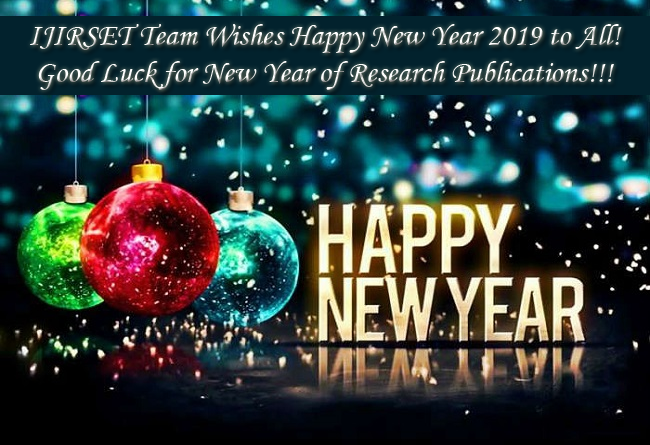Submission of articles:
Authors are invited to submit the papers as per the IJIRSET Single column format to
This email address is being protected from spambots. You need JavaScript enabled to view it.
. Submissions must be original and should not have been published previously or be under consideration for publication while being evaluated for this journal.
Download IJIRSET Single column paper template
Download IJIRSET Copy Right Form
Type of Articles Accepted:
- Research Paper
- Survey Paper
- Review Paper
- Informative Paper
- Case Studies
- Comparative Studies
- Extended version of conference or Journal paper etc
Guidelines to Contributors
ABSTRACT
Meaning: A short summary of the entire paper.
Purpose: To give readers a quick overview of your research, including the problem, method, key results, and conclusion — usually in 150–250 words.
KEYWORDS
Meaning: Important terms or phrases relevant to your study.
Purpose: Help index your paper in databases so others can find it using search terms (e.g., “Machine Learning,” “IoT,” “Wireless Sensor Network”).
I. INTRODUCTION
Meaning: The opening section of the paper.
Purpose: To introduce the research topic, explain why it matters, describe existing problems, and state your objective or goal.
II. LITERATURE SURVEY
Meaning: A review of previous work or studies related to your topic.
Purpose: To show what has already been done, identify gaps or limitations, and justify why your research is necessary.
III. PROPOSED METHODOLOGY AND DISCUSSION
Meaning: A detailed description of the system, model, or method you are proposing, along with reasoning.
Purpose: To explain how your research was conducted (step-by-step) and why your chosen approach is appropriate. This section often includes diagrams, algorithms, or architecture.
IV. RESULTS
Meaning: Presentation and analysis of the outcomes from your experiments or model testing.
Purpose: To show evidence that your proposed method works, usually through charts, tables, accuracy scores, or other statistical data.
V. CONCLUSIONS
Meaning: The final summary of your findings.
Purpose: To wrap up your research, restate key contributions, and suggest areas for future improvement or study.
REFERENCES
Meaning: A list of all the academic sources, books, articles, or websites you cited.
Purpose: To credit other researchers and support your claims with verified information. Use a consistent citation style (APA, IEEE, etc.).
Publication Process:
Step 1: The author submits the manuscript to the editor via email.
Step 2: The editor conducts an initial screening and forwards the manuscript to qualified reviewers based on their subject expertise.
Step 3: The reviewers assess the manuscript and submit their recommendations to the editor (Accepted / Revisions Required / Rejected).
Step 4: The editorial board communicates the review decision to the author.
Step 5: If revisions are requested, the author updates the manuscript and submits the final version (in Word format) along with the signed copyright form and proof of payment (receipt or payment screenshot) via email to the editor.
Step 6: The Editor-in-Chief evaluates the final submission and authorizes the publication of the accepted paper.
Step 7: The Editor-in-Chief provides the published article link to the author.
Volume 14, Issue 12, December 2025

Disclaimer : Prospective authors should note that only original and previously unpublished research papers will be considered. Furthermore, simultaneous submissions (under consideration for publication elsewhere) are not acceptable. Submission of a manuscript is interpreted as a statement of certification that no part of the manuscript is copyrighted by any other publication nor is under review by any other formal publication. It is the primary responsibility of the author to obtain proper permission for the use of any copyrighted materials in the manuscript, prior to the submission of the manuscript to IJIRSET.


 IJIRSET Launched Hard copy Publication and Hard copy of Certificates from Vol.4, Issue 1, January 2015 issue.
IJIRSET Launched Hard copy Publication and Hard copy of Certificates from Vol.4, Issue 1, January 2015 issue.














